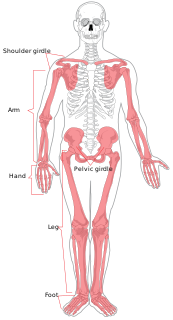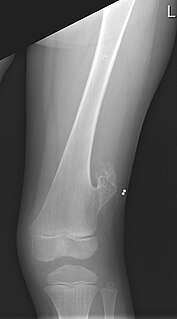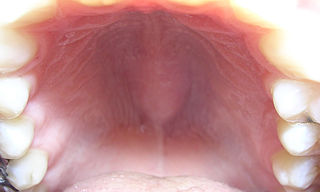
A bone is a rigid organ that constitutes part of the vertebrate skeleton. Bones protect the various organs of the body, produce red and white blood cells, store minerals, provide structure and support for the body, and enable mobility. Bones come in a variety of shapes and sizes and have a complex internal and external structure. They are lightweight yet strong and hard, and serve multiple functions.
A ligament is the fibrous connective tissue that connects bones to other bones. It is also known as articular ligament, articular larua, fibrous ligament, or true ligament. Other ligaments in the body include the:

The skull is a bony structure that forms the head in vertebrates. It supports the structures of the face and provides a protective cavity for the brain. The skull is composed of two parts: the cranium and the mandible. In the human, these two parts are the neurocranium and the viscerocranium or facial skeleton that includes the mandible as its largest bone. The skull forms the anterior most portion of the skeleton and is a product of cephalisation—housing the brain, and several sensory structures such as the eyes, ears, nose, and mouth. In humans these sensory structures are part of the facial skeleton.

A joint or articulation is the connection made between bones in the body which link the skeletal system into a functional whole. They are constructed to allow for different degrees and types of movement. Some joints, such as the knee, elbow, and shoulder, are self-lubricating, almost frictionless, and are able to withstand compression and maintain heavy loads while still executing smooth and precise movements. Other joints such as sutures between the bones of the skull permit very little movement in order to protect the brain and the sense organs. The connection between a tooth and the jawbone is also called a joint, and is described as a fibrous joint known as a gomphosis. Joints are classified both structurally and functionally.

The appendicular skeleton is the portion of the skeleton of vertebrates consisting of the bones that support the appendages. The appendicular skeleton includes the skeletal elements within the limbs, as well as supporting pectoral and pelvic girdle. The word appendicular is the adjective of the noun appendage, which itself means a part that is joined to something larger.

The human musculoskeletal system is an organ system that gives humans the ability to move using their muscular and skeletal systems. The musculoskeletal system provides form, support, stability, and movement to the body.

Hyperdontia is the condition of having supernumerary teeth, or teeth that appear in addition to the regular number of teeth. They can appear in any area of the dental arch and can affect any dental organ. The opposite of hyperdontia is hypodontia, where there is a congenital lack of teeth, a condition which is seen more commonly than hyperdontia. The scientific definition of hyperdontia is "any tooth or odontogenic structure that is formed from tooth germ in excess of usual number for any given region of the dental arch." The additional teeth, which may be small in number, or many, can occur on any place in the dental arch. Their arrangement may be symmetrical or non-symmetrical.

A dental implant is a surgical component that interfaces with the bone of the jaw or skull to support a dental prosthesis such as a crown, bridge, denture, facial prosthesis or to act as an orthodontic anchor. The basis for modern dental implants is a biologic process called osseointegration, in which materials such as titanium form an intimate bond to bone. The implant fixture is first placed so that it is likely to osseointegrate, then a dental prosthetic is added. A variable amount of healing time is required for osseointegration before either the dental prosthetic is attached to the implant or an abutment is placed which will hold a dental prosthetic.

Fibrodysplasia ossificans progressiva (FOP) is an extremely rare connective tissue disease. It is a severe, disabling disease with no cure or treatment and is the only known medical condition where one organ system changes into another.

An exostosis, also known as bone spur, is the formation of new bone on the surface of a bone. Exostoses can cause chronic pain ranging from mild to debilitatingly severe, depending on the shape, size, and location of the lesion. It is most commonly found in places like the ribs, where small bone growths form, but sometimes larger growths can grow on places like the ankles, knees, shoulders, elbows and hips. Very rarely are they on the skull.

Maceration is a bone preparation technique whereby a clean skeleton is obtained from a vertebrate carcass by leaving it to decompose inside a closed container at near-constant temperature. This may be done as part of a forensic investigation, as a recovered body is too badly decomposed for a meaningful autopsy, but with enough flesh or skin remaining as to obscure macroscopically visible evidence, such as cut-marks. In most cases, maceration is done on the carcass of an animal for educational purposes.

Wormian bones, also known as intrasutural bones or sutural bones, are extra bone pieces that can occur within a suture (joint) in the skull. These are irregular isolated bones that can appear in addition to the usual centres of ossification of the skull and, although unusual, are not rare. They occur most frequently in the course of the lambdoid suture, which is more tortuous than other sutures. They are also occasionally seen within the sagittal and coronal sutures. A large wormian bone at lambda is often called an Inca bone, due to the relatively high frequency of occurrence in Peruvian mummies. Another specific Wormian bone, the pterion ossicle, sometimes exists between the sphenoidal angle of the parietal bone and the great wing of the sphenoid bone. They tend to vary in size and can be found on either side of the skull. Usually, not more than several are found in a single individual, but more than one hundred have been once found in the skull of a hydrocephalic adult.

Kangnasaurus is a genus of iguanodontian ornithopod dinosaur found in supposedly Early Cretaceous rocks of South Africa. It is known from a tooth and possibly some postcranial remains. At times, it has been considered dubious or a valid genus. It was probably similar to Dryosaurus.

Slahal is a gambling game of the indigenous peoples of the Pacific Northwest Coast, also known as stickgame, bonegame, bloodless war game, handgame, or a name specific to each language. It is played throughout the western United States and Canada by indigenous peoples. Traditionally, the game uses the shin bones from the foreleg of a deer or other animal. The name of the game is a Chinook Jargon word.

A karvalakki is a cylinder-shaped, furry forage cap-styled hat typically worn in parts of Finland and Russia. Finnish TV presenter Hannu Karpo often wore a karvalakki on his show, Karpolla on asiaa.

In human anatomy, the neurocranium, also known as the braincase, brainpan, or brain-pan is the upper and back part of the skull, which forms a protective case around the brain. In the human skull, the neurocranium includes the calvaria or skullcap. The remainder of the skull is the facial skeleton.
Progressive osseous heteroplasia is a cutaneous condition characterized by cutaneous or subcutaneous ossification.

Bathyotica is a clade of crurotarsan archosaurs that includes the superorder Crocodylomorpha and its sister taxon Erpetosuchus, a small Triassic suchian. Bathyotica was named in a 2002 phylogenetic study of Erpetosuchus. The genus was found to be closely related to crocodylomorphs, and Bathyotica was erected to encompass both taxa.

Muscles are described using unique anatomical terminology according to their actions and structure.



















